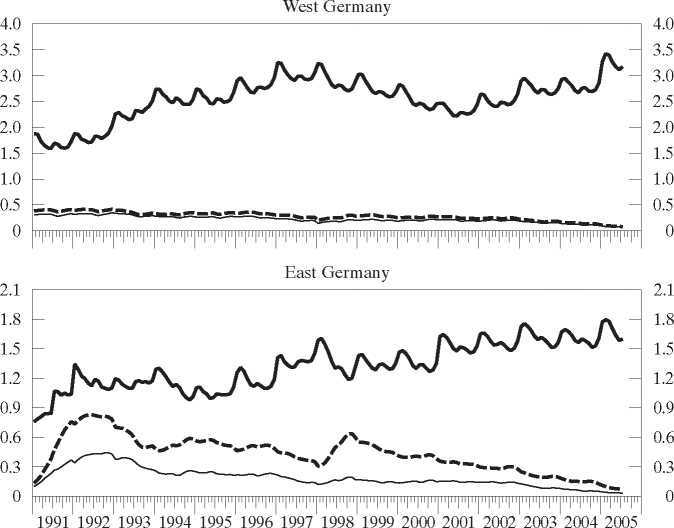Performance of Active Labour Market Policy in Germany
Figure 1
Unemployment and ALMP Participation in Germany
1991 to 2005; in millions

— unemployed persons
----training programme participants - — - job creation programme participants
Source: IAB Nürnberg.
ployed, in contrast, were - and still are - comparable to many other OECD
countries. Unemployment benefits were financed by unemployment in-
surance contributions shared by employers and employees, while unem-
ployment assistance was financed by taxes. In principle, unemployment as-
sistance was means-tested on a yearly base. It was possible to complement un-
employment insurance by tax-financed social assistance. Generally, every
household whose income fell below a certain income threshold qualified for
social assistance. The German benefit system combined generous benefit
levels with high benefit reduction rates that taxed away most of the additional
earned income of a benefit recipient. Thus, incentives to take up a job were
very low, especially for low skilled workers. Engels (2001) calculates that a
typical family with three children receiving social assistance in West Germany
in the year 2000 received an income that was only 15.3% below the income of a
More intriguing information
1. EFFICIENCY LOSS AND TRADABLE PERMITS2. Imputing Dairy Producers' Quota Discount Rate Using the Individual Export Milk Program in Quebec
3. Effects of a Sport Education Intervention on Students’ Motivational Responses in Physical Education
4. INTERACTION EFFECTS OF PROMOTION, RESEARCH, AND PRICE SUPPORT PROGRAMS FOR U.S. COTTON
5. Dual Track Reforms: With and Without Losers
6. Population ageing, taxation, pensions and health costs, CHERE Working Paper 2007/10
7. Towards Learning Affective Body Gesture
8. Linking Indigenous Social Capital to a Global Economy
9. Equity Markets and Economic Development: What Do We Know
10. SAEA EDITOR'S REPORT, FEBRUARY 1988